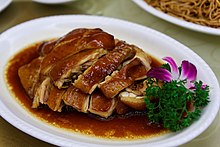List of soy-based foods
Appearance

This is a list of soy-based foods. The soybean is a species of legume native to East Asia, widely grown for its edible bean which has numerous uses. The plant is classed as an oilseed rather than a pulse by the UN Food and Agriculture Organization (FAO). Many foods and dishes are prepared using soybeans as a primary ingredient.
Soy-based foods
[edit]



- Abura-age – Deep-fried tofu slices
- Cheonggukjang – Korean fermented soybeans
- Doenjang – Fermented soybean paste[1]
- Doubanjiang – Chinese spicy bean paste
- Douchi – Fermented and salted black soybean
- Dougan – firm variety of tofu
- Edamame – Immature soybean pod used as a specialty food
- Fermented bean paste – Fermented foods made from ground soybeans
- Kinako – Roasted soybean flour
- Kinema – Nepali fermented soybean
- Koya dofu – Type of tofu
- Lufu (food) – Type of fermented bean curd
- Mamenori – Thin wrappers of soybean paper used as a substitute for nori
- Miso – Traditional Japanese seasoning
- Nattō – Traditional Japanese food made from fermented soybeans
- Okara (food) – Byproduct of tofu production
- Oncom – Indonesian traditional fermented dish
- Soup soy sauce – Type of Korean soy sauce
- Soybean – Legume grown for its edible bean
- Soybean oil – Oil obtained from seeds of soya plant
- Soybean sprout – Culinary vegetable
- Soy milk – Beverage made from soybeans
- Soy molasses – Viscous syrup with a typical bittersweet flavor
- Soy nut – Soaked, drained and baked soybeans
- Soy protein – A protein that is isolated from soybean
- Soy sauce – East Asian liquid condiment
- Soy yogurt – A yogurt-like product prepared with soy milk
- Sweet bean sauce – Sweet savory sauce in China and Korea
- Tauco – Indonesian fermented bean paste
- Tempeh – Soy product from Indonesia, used as protein source
- Textured vegetable protein – Defatted soy flour food product
- Thua nao – Traditional Shan food made from fermented soybeans
- Tofu – Soy-based food used as a protein source
- Fermented bean curd – Chinese condiment
- Stinky tofu – Chinese fermented tofu with a strong odor
- Tofu skin – Chinese and Japanese food made from soybeans
- Bai ye – Chinese and Japanese food made from soybeans
- Tofu skin roll – Chinese wrap dish
- Tương – Condiment made from soybeans
- Yellow soybean paste – Chinese fermented soybean paste
Dishes
[edit]
- Agedashi dōfu – Japanese tofu dish
- Dubu kimchi – Korean tofu and stir-fried kimchi dish
- Hiyayakko – Japanese tofu dish
- Kongguksu – Korean noodle dish in soy milk broth
- Mapo doufu – Sichuan cuisine dish
- Soy sauce chicken – Traditional Cantonese dish
- Sukiyaki – Japanese hot pot dish
- Sundubu jjigae – Korean traditional soft tofu stew
- Tahu goreng – Southeast Asian fried tofu dish
- Teriyaki – Japanese marinade
- Yong Tau Foo – Tofu filled with ground meat or fish
- Zunda – Japanese regional cuisine
Product brands
[edit]
- 8th Continent – a brand of soy milk
- Alpro – Food company
- Beanfeast – Vegetarian processed food
- Boca Burger – Veggie burger produced by Kraft Heinz
- Eden Foods Inc. – American organic food company
- Gardein – Line of foods by Conagra Brands
- Kikkoman – Japanese food manufacturer
- La Loma Foods – US vegetarian food brand
- Lightlife – American company producing vegetarian and vegan meat substitutes
- Little Soya
- Plamil Foods – British manufacturer of vegan foods
- Silk (soy milk) – American brand of dairy substitute products
- So Good (soy beverage) – Business enterprise owned by the Seventh-day Adventist Church
- Tofurky – American vegan turkey replacement
- Tofutti
- Vitasoy – Hong Kong beverage company
- Yeo Hiap Seng – Singaporean beverage company
See also
[edit]References
[edit]Wikimedia Commons has media related to Soy foods.
- ^ Tamang, J.P. (2016). Ethnic Fermented Foods and Alcoholic Beverages of Asia. Springer India. p. 268. ISBN 978-81-322-2800-4. Retrieved June 10, 2022.

